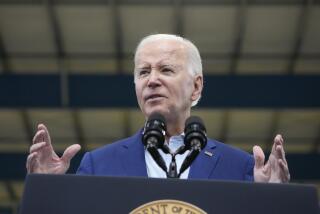Manufacturers Out Front in Productivity Tally
- Share via
WASHINGTON — Manufacturers improved their productivity at an annual rate of more than 5% in the third quarter, the government said Monday, but other businesses had more difficulty in keeping increases in their labor costs below the rate of inflation.
The Labor Department reported a 5.2% increase in productivity on assembly lines. A 7.2% jump in annual output was accompanied by only a 1.8% jump in employment and overtime to accomplish it.
The net productivity figure is usually close but not identical to the difference between output and costs because it is computed differently.
Businesses as a whole did not fare as well, continuing a trend that began with the recovery from the 1981-82 recession and offering little hope for raising the nation’s living standards.
Productivity among non-farm businesses--including the service sector that now accounts for about half of the nation’s economic activity--improved by just 1.9% on 3.4% higher output and a 1.5% rise in hours worked.
During the past 12 months, non-farm business productivity has risen by only 0.9%, compared to 0.8% for all of 1987. That is one-third the rate in 1983, the first year coming out of the recession, and half the rates of 1984 and 1986.
“It’s pretty puny,” said Michael Evans, who runs an economic forecasting firm in Washington. “The ability to raise our standard of living is hardly improving at all. That’s the real effect of the budget deficits and these leveraged buyouts.”
“We’re spending all these billions on interest payments instead of capital improvements, research and development and infrastructure,” he said. “That’s our major economic problem, and we don’t seem to be attacking it.”
Still, the 1.9% improvement in efficiency was better than the 1.3% estimated earlier, before the government last week revised the nation’s gross national product upward for the third quarter. It also nearly offset a 2.4% decline in productivity in the second quarter.
Innovation Cited
“It’s a strong number when you consider that, traditionally, productivity tends to level off when we get close to full utilization” of labor and plant resources, said Robert Lawrence, an economist for the Brookings Institution, a Washington think tank.
“It suggests that the improvement is coming from innovation instead of just using idle resources more fully,” Lawrence said.
Hourly compensation costs, led by what analysts said were larger wage gains among lower-paid service workers and higher Social Security taxes on employers, rose at an annual rate of 5.6% in the third quarter and are 4.9% above what they were a year ago.
That raised unit labor costs in the non-farm business sector for the third quarter at an annual rate of 3.7%. Including a 6.8% annual rise the second quarter and a 5.4% jump the last three months of 1988, labor costs are now 4% above what they were a year ago, barely below the 4.4% increase in consumer prices over the same period.
“This is a distinctive sign of worse inflation to come and growing pressure on profit margins,” said Allen Sinai, chief economist for Boston Co., a New York financial consulting house.
The 5.2% increase in more narrow category of manufacturing productivity was the best improvement since a 5.5% gain in the spring of 1987.
Other Labor Department data shows that assembly line hiring slowed considerably during the summer, with only a net gain of 5,000 new factory jobs in the third quarter, compared to 425,000 new jobs during the past year.
Expects Turnaround
Analysts attributed much of the slowdown in assembly line hiring to the drought, which caused canneries and other food-processing operations to add fewer employees than normal after harvests.
With the creation of 160,000 new factory jobs in October and November and assembly line workers continuing to average four hours of overtime each week, Sinai said manufacturing productivity improvements also are bound to fade soon.
“No matter what the increase in GNP in the fourth quarter, there will be a huge increase in hours worked and labor costs, and we haven’t even had any strong wage bargaining yet,” he said. “This is probably the last of the good news.”
The Labor Department data showed hourly employee compensation costs in manufacturing rising at an annual rate of 4.7% in the third quarter, compared to an annualized gain of only 3% in the spring.
However, after accounting for inflation, factory workers saw no increase in their purchasing power from the compensation gains. And, during the past year, they actually have lost 0.3% in buying power despite nominal wage and benefit gains of 3.8%, the Labor Department said.
Still, the increased productivity enabled factories to reduce their unit labor costs by 0.5% in the third quarter after a 0.7% decline in the second quarter.
And during the past 12 months, the labor costs associated with each item coming off an assembly line are up only 0.4%. They had declined by 1.2% in 1987, when the United States, Japan and France were the only three major industrialized nations to reduce unit labor costs in manufacturing from 1986.
More to Read
Inside the business of entertainment
The Wide Shot brings you news, analysis and insights on everything from streaming wars to production — and what it all means for the future.
You may occasionally receive promotional content from the Los Angeles Times.










